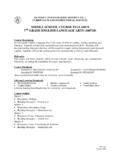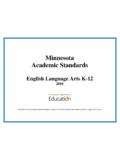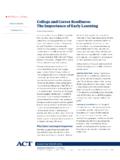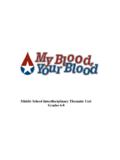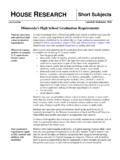Transcription of Michigan’s Statewide Comprehensive Literacy Plan …
1 michigan s Statewide Comprehensive Literacy plan (MiLit plan ) Literacy for Equity, Literacy for Prosperity, Literacy for Society DRAFT 3 Table of Contents I. Introduction .. 4 Background and Purpose: Literacy for Equity Expanded View of Literacy for the 21st Century: Literacy for Prosperity, Literacy for Society State Literacy Team: MiLit plan Goals and Action Steps II. Background and Status of michigan Literacy Trends .. 13 III. Review of Literacy Research for MiLit plan .. 20 IV. michigan Statewide Comprehensive Literacy plan The MiLitPlan .. 39 V. Appendices Appendix 1: MiLit plan : Phase 1 43 Appendix 2: Regional plan 46 Appendix 3: Literacy Assessment Achievement 47 Appendix 4: Research 48 Appendix 5: References.
2 52 DRAFT 4 I. Introduction Once you learn to read, you will be forever free - Frederick Douglas, 1845 Background and Purpose: Literacy for Equity Over a century of educational and Literacy reforms have sought to address deeply entrenched educational and opportunity divides (Ravitch, 2000). Historically, economically disadvantaged, African-American, and Hispanic students have scored significantly below their more privileged Caucasian counterparts in reading and writing achievement (Frankenberg, 2004; NAEP, 2010; Wong, 2003). There has also been a recent demographic shift in schools and neighborhoods coined re-segregation. Re-segregation trends since the mid-1990s have resulted in more racially and economically polarized schools than have been seen in forty years, according to the Harvard Civil Rights Project (2003).
3 Kozol (2005) refers to this phenomenon as the new apartheid of our education system, indicting both the school-of-choice and voucher movements. The historic divides, as well as the more recent demographic trends reflect the legacy of slavery and racial discrimination, which have hindered minorities from obtaining educational and economic equity for over 200 years. More recent state and federal Literacy reforms can be viewed through the lens of President Johnson s Great Society agenda of the 1960s, which sought to ameliorate persistent inequities for poor and minority Americans. Johnson s platform included the first major educational federal funding for poor children, the 1965 Elementary and Secondary Education Act (ESEA).
4 To date, the No Child Left Behind Act (2001) and its Reading First legislation have represented the most DRAFT 5ambitious attempts in the continuing federal effort to reduce long-standing achievement gaps for poor and minority children, gaps that some fear may actually increase with re-segregation and school-of-choice trends (Anyon, 1997; Darling-Hammond, 2004; Kozol, 2005; Wong, 2003). The federal call, therefore, for Statewide Comprehensive Literacy programs in 2011 is more urgent and necessary than ever. While national trends and michigan outcomes demonstrate limited progress in closing reading achievement gaps over the last decade ( michigan Educational Assessment Program [MEAP], 2010; NAEP, 2010), the progress has been slow and uneven (CEP, 2010).
5 It is time for michigan shareholders to share responsibility for the persistent, significant, and unconscionable gaps in the state s Literacy achievement. For the first time in its history, the michigan Statewide Comprehensive Literacy plan (MiLit plan or plan ) provides a platform for michigan Literacy leaders to work in concert for the shared goal of increased and sustained Literacy achievement for all michigan citizens from cradle to career. The time has come for Michiganians to drive this work together as we shift gear for 21st Century growth and demands. Expanded View of Literacy for the 21st Century: Literacy for Prosperity, Literacy for Society Literacy does not concern only individuals, as a rights and capabilities framework may suggest; it also has a critical social dimension (UNESCO, Literacy for Life, 2006).
6 The 21st Century has brought new dimension to the needs of society and the economy, which are naturally reflected in our schools and other social organizations. The rapid development, application, and pervasiveness of technology, as well as an influx of English language learners (ELLs), require that DRAFT 6our conception of and approach to teaching Literacy evolve. As the nation and the world work to emerge from the financial crisis of the last three years, the rebuilding is uniquely challenging for michigan . As two of the Big Three Automakers, from the industry that had sustained michigan for the last century, fell into bankruptcy, good-paying, low-education jobs became essentially a relic of the past.
7 michigan s labor force has shrunk by nearly 400,000 workers over the past decade while unemployment has risen from a low of in 2000 to a high of in 2010 ( Department of Labor, Bureau of Labor Statistics, 2010). In these challenging economic times, a renewed focus on ensuring that all citizens are literate is essential. Literacy has the potential to meet people s most vital needs and to stimulate social, cultural, political, and economic participation, especially on the part of disadvantaged groups (UNESCO, Literacy for Life, 2006). As michigan transitions to a knowledge-based economy for its path to prosperity (Glazer, 2010), it is with the understanding that the foundation for this new economy is our literate citizenry.
8 Expanded Definitions of Literacy The MiLit plan defines Literacy generally as: the ability to read, write, speak, and listen in order to comprehend and communicate common meaning in various settings; our extended definition includes oral, written, visual, and digital forms of expression. The MiLit plan further underscores that the function of Literacy is to enable individuals to achieve their goals, develop their knowledge and potential, and participate fully in their community and wider society (see UNESCO, 2003). DRAFT 7 The Common Core State Standards (CCSS), adopted by michigan in June 2010, set a rigorous bar for college and career readiness in Literacy a level that all michigan students, regardless of current levels of performance, will be prepared to meet in order to build a strong, prosperous, and democratic state.
9 As the CCSS in English Language Arts articulate, a literate person in the 21st Century must demonstrate independence; build strong content knowledge; respond to the varying demands of audience, task, purpose, and discipline; comprehend as well as critique; value evidence; use technology and digital media strategically and capably; and come to understand other perspectives and cultures ( ). These expanded definitions underscore MiLit plan s vision statement: Literacy for Equity, Literacy for Prosperity, Literacy for Society. State Literacy Team, MiLit plan Goals and Action Steps The michigan Department of Education (MDE) convened a group of 50 Literacy experts from across the state in May 2010 to begin the work of developing the michigan Statewide Comprehensive Literacy plan (MiLit plan ).
10 The larger State Literacy Team (Team) includes 86 members of shareholders representing K-12 education, public libraries, higher education, early childhood education, English language learners, students with disabilities, community and nonprofit organizations, and the various geographic regions across the state. The Team will work cooperatively to oversee the implementation of the MiLit plan through the establishment of MiLit Regional Teams and the MiLit Network website (see Section IV). The Team s work will be guided by the plan s goals, action steps, and core DRAFT 8components. The plan will be implemented over a five-year period beginning in September 2011 with full implementation by 2016.
